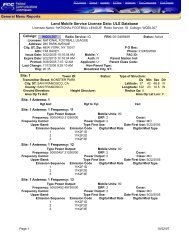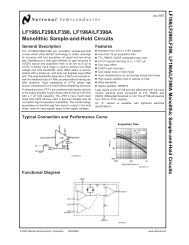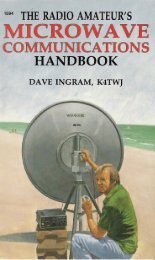A License Plate Recognition and Speed Detection System - Index of
A License Plate Recognition and Speed Detection System - Index of
A License Plate Recognition and Speed Detection System - Index of
You also want an ePaper? Increase the reach of your titles
YUMPU automatically turns print PDFs into web optimized ePapers that Google loves.
I will discuss the pathway the input signal takes through the readout circuit from the input jack to<br />
the 7-segment LED display. For brevity, I will ignore the headphone, calibration, <strong>and</strong> gain<br />
control circuitry.<br />
Two six-volt dry cell lantern batteries connected in series powers the readout display. The<br />
input power is separated by a voltage divider circuit (formed by resisters R1 <strong>and</strong> R2), to give a<br />
12 volt supply <strong>and</strong> a 6 volt supply needed by the integrated circuit (IC) chips.<br />
The signal from the microwave oscillator enters the readout circuit via the signal jack, J1.<br />
The signal is amplified by passing through all four stages <strong>of</strong> an LM324 Quad Op-Amp. The<br />
input signal is applied to the non-inverting pin <strong>of</strong> each amplifier stage <strong>and</strong> negative feedback<br />
loops are used to control the gain <strong>and</strong> prevent the op-amp from going into saturation. The gain<br />
(G) in a negative feedback loop is controlled by the values <strong>of</strong> the resistors in the voltage divider<br />
configuration in the specific loop. The gain (G) = 1 + R2/R1.<br />
The amplified signal leaves the last stage <strong>of</strong> the LM324 Op-amp at pin 7 <strong>and</strong> is directed<br />
to the input pin <strong>of</strong> a 4093 Quad Schmitt trigger NAND IC. A Schmitt trigger has the unique<br />
ability to convert any type <strong>of</strong> input waveform into a square wave output <strong>and</strong> at the same time<br />
acting as a noise filter. The graph below (figure 34) shows an arbitrary waveform at the top <strong>of</strong><br />
the graph <strong>and</strong> the resulting output after passing through a Schmitt trigger. The Schmitt trigger is<br />
a type <strong>of</strong> comparator IC that uses two independently set thresholds. When the input waveform is<br />
below the lower threshold, the Schmitt trigger’s output is low. When the input waveform is<br />
above an upper threshold, the Schmitt trigger’s output goes high. The Schmitt trigger’s output<br />
changes only at those times when the input waveform’s trailing edge crosses the upper threshold<br />
45

















